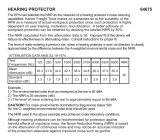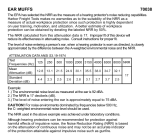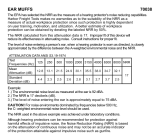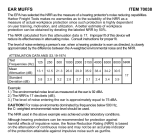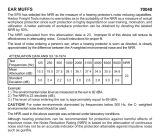
2
n Warning!
This hearing protector helps reduce exposure to hazardous noise and other loud sounds.
Misuse or failure to wear hearing protection at all times when exposed to hazardous
noise may result in hearing loss or injury. For proper use, see supervisor, User
Instructions, or contact 3M Technical Service. If your hearing seems dulled or you hear
a ringing or buzzing during or after any noise exposure (including gunfire), or for any other
reason you suspect a hearing problem, leave the noisy environment immediately and
consult a medical professional and/or your supervisor.
n Warnings!
Failure to follow these instructions may result in serious injury or death:
Listening to music or other audio communication may reduce your situational
awareness and ability to hear warning signals. Stay alert and adjust the audio
volume to the lowest acceptable level.
Failure to follow these instructions may reduce the protection provided by the
earmuff and may result in hearing loss:
a. 3M strongly recommends individual fit testing of hearing protectors. If the NRR is
used to estimate typical workplace protection, 3M recommends that the noise
reduction value be reduced by 50% or in accordance with applicable regulations.
b. Ensure the hearing protector is properly selected, fit, adjusted, and maintained.
Improper fit of this device will reduce its effectiveness in attenuating
noise. Consult the enclosed instructions for proper fit.
c. Inspect the hearing protector before each use. If damaged, select an undamaged
hearing protector or avoid the noisy environment.
d. When additional personal protective equipment is necessary (e.g. safety glasses,
respirators, etc.), select flexible, low profile temples or straps to minimize
3M™ PELTOR™ COMTAC/SWAT-TAC Headset User Instructions MT17H682 Series
Introduction
Congratulations and thank you for choosing 3M™ PELTOR™ Protective Communication
Solutions! The 3M™ PELTOR™ COMTAC/SWAT-TAC Headset is a hearing protection device
that helps provide the wearer environmental listening capabilities and is designed to be worn
under an Advanced Combat Helmet (ACH) or Modular Integrated Communication Helmet
(MICH) for use with a variety of noise exposures. Auditory Environmental Awareness describes
the ability to use information gathered from the users environment through his/her sense
of hearing. This includes sound detection, localization, distance estimation, face to face
communication, and any other use of human hearing. Individuals such as soldiers spend
significant time in a quiet environment where auditory environmental awareness is critical,
yet have the need for on-demand hearing protection from weapons fire and other hazardous
noise. A familiarization period, where the user adapts to the differences in auditory information
as it comes though the tactical communications headset, is highly recommended.
Welcome to the next generation of tactical, protective communication.
Important
Please read, understand, and follow all safety information in these instructions prior to use.
Retain these instructions for future reference. For additional information or any questions,
contact 3M Technical Service (contact information listed on the last page).













